Perovskite sensors - Page 6
New production method yields flexible single-crystal perovskite films with controlled area, thickness, and composition
Scientists at UC San Diego have developed a new method to fabricate perovskites as single-crystal thin films, which are more efficient for use in solar cells and optical devices than the current state-of-the-art polycrystalline forms of the material.
Their fabrication method - which uses standard semiconductor fabrication processes - results in flexible single-crystal perovskite films with controlled area, thickness, and composition. These single-crystal films showed fewer defects, greater efficiency, and enhanced stability than their polycrystalline counterparts, which could lead to the use of perovskites in solar cells, LEDs, and photodetectors.
Graphene boosts perovskite single crystal photodetector performance
The performance of photodetectors based on perovskite polycrystalline thin films is still considered to be at a distance from expected values. One reason is that the carrier transport at the interface is easily affected by grain boundaries and grain defects. Many research groups have tried to combine perovskite polycrystalline thin films with high-mobility, two-dimensional materials to improve device performance, and have achieved promising results, but the negative effects of perovskite polycrystalline grain boundaries still remain.
To solve this problem, a team led by Assoc. Prof. Yu Weili from Changchun Institute of Optics, Fine Mechanics and Physics (CIOMP) of the Chinese Academy of Sciences, and Prof. GUO Chunlei from the University of Rochester synthesized a low-surface-defect-density CH3NH3PbBr3 microplate through the inverse temperature crystallization strategy. They prepared an effective vertical structure photodetector combining a high-quality perovskite single crystal with monolayer graphene with high carrier mobility.
Microscopic structures could improve the efficiency of perovskite solar cells
An international research team, led by Stefan Weber from the Max Planck Institute for Polymer Research in Mainz, has found microscopic structures in perovskite crystals that can guide the charge transport in the solar cell.
Clever alignment of these electron highways could make perovskite solar cells more efficient. When solar cells convert sunlight into electricity, the electrons of the material inside the cell absorb the energy of the light. The electrons excited by the sunlight are collected by special contacts on the top and bottom of the cell. However, if the electrons remain in the material for too long, they can lose their energy again. To minimize losses, they should therefore reach the contacts as quickly as possible. Microscopically small structures in the perovskites - so-called ferroelastic twin domains - could be helpful in this respect: They can influence how fast the electrons move.
Graphene "shield" improves the stability of perovskite solar cells
A UNIST research team has developed an electrode that can significantly improve the stability of perovskite solar cells. UNIST announced that its research team developed 'flexible and transparent metal electrode-based perovskite solar cells with a graphene interlayer'.

The team suppressed interdiffusion and degradation using a graphene material with high impermeability, the team said. Team leader professor Hyesung Park commented that the research will greatly help not only solar cells but other perovskite-based flexible photoelectric devices such as LEDs and smart sensors.
Researchers develop halide double perovskite ferroelectrics
A research group led by Prof. Luo Junhua from Fujian Institute of Research on the Structure of Matter (FJIRSM) of the Chinese Academy of Sciences reported the first halide double perovskite ferroelectric, (n-propylammonium)2CsAgBiBr7, which exhibits distinct ferroelectricity with a notable saturation polarization of about 1.5 μCcm-2.
Halide double perovskites have been found to be a promising environmentally friendly optoelectronic and photovoltaic material, exhibiting inherent thermodynamic stability, high defect tolerance and appropriate band gaps. However, no ferroelectric material based on halide double perovskites has been discovered until now.
Perovskite/graphene nanosensor detects nitrogen dioxide with 300% improved sensitivity
A research team led by Juan Casanova and Eduard Llobet from the Departamento de IngenierÃa Electrónica, Eléctrica y Automática at the Universitat Politècnica de València (URV), used graphene and perovskites to create a nanosensor that detects nitrogen dioxide with 300% improved sensitivity.
The team used graphene that is hydrophobic (water and moisture-resistant) and sensitive in gas detection, but with some limitations: it is not very selective and its sensitivity declines over time. In addition, the researchers used perovskites, a crystalline-structure material commonly used in the field of solar cells. However, they quickly deteriorate when they are exposed to the atmosphere. That's the reason why the team decided to combine perovskites with a hydrophobic material able to repel water molecules - in order to prove they can prevent or slow down their deterioration.
Perovskite X-Ray detectors could revolutionize imaging for medicine, security and research
Researchers at Los Alamos National Laboratory and Argonne National Laboratory have designed a new perovskite-based X-ray detector prototype that might revolutionize medical imaging, with dramatic reduction in radiation exposure and the associated health risks, while also boosting resolution in security scanners and research applications.

'The perovskite material at the heart of our detector prototype can be produced with low-cost fabrication techniques,' said Hsinhan (Dave) Tsai, an Oppenheimer Postdoctoral fellow at Los Alamos National Laboratory. 'The result is a cost-effective, highly sensitive, and self-powered detector that could radically improve existing X-ray detectors, and potentially lead to a host of unforeseen applications.'
Perovskite diodes enable bidirectional optical signal transmission between two identical devices
Researchers at Linköping University, in collaboration with colleagues in China, have developed a tiny unit that is both an optical transmitter and a receiver. "This is highly significant for the miniaturization of optoelectronic systems," says LiU professor Feng Gao.
Chunxiong Bao, postdoc at Linköping University, types in a sentence on a computer screen, and the same sentence immediately appears on the neighboring screen, optically transferred from one diode to another. The diode is made from perovskite.
Researchers develop ultrafast, broadband perovskite photodetectors for large-dynamic-range imaging
Researchers at the Chinese Academy of Sciences (CAS) and other collaborators have reported a solution-processed broadband photodetector based on organic-inorganic hybrid perovskite and organic bulk heterojunction, achieving broadband response spectra up to 1000 nm with a high EQE in the NIR region, an ultrafast response speed of 5.6 ns and a wide linear dynamic range of 191 dB.

The team stated that thanks to the high-dynamic-range imaging capacity, high-quality visible-NIR actual imaging is obtained, enabling the accelerated translation of solution-processed photodetector applications from the laboratory to the imaging market.
Strain may enable better perovskite solar cells
Researchers from the University of California San Diego, King Abdullah University of Science and Technology and the Air Force Research Laboratory have developed a technique that could enable the fabrication of longer-lasting and more efficient perovskite solar cells, photodetectors, and LEDs.
 Strain-engineered, single crystal thin film of perovskite grown on a series of substrates with varying compositions and lattice sizes. Image Credit: David Baillot/UC San Diego Jacobs School of Engineering.
Strain-engineered, single crystal thin film of perovskite grown on a series of substrates with varying compositions and lattice sizes. Image Credit: David Baillot/UC San Diego Jacobs School of Engineering.
A major obstacle is the tendency of one of the best-performing perovskite crystals, α-formamidinium lead iodide (HC(NH2)2PbI3, known as α-FAPbI3), to assume a hexagonal structure at room temperature, in which photovoltaic devices are required to operate. This hexagonal structure cannot respond to most of the frequencies of light in solar radiation, and is hence not useful for solar applications as it could be. The team therefore set out to stabilize the structure of α-FAPbI3, using a simple but useful approach known as strain engineering, which has been used to tune the electronic properties of semiconductors.
Pagination
- Previous page
- Page 6
- Next page



